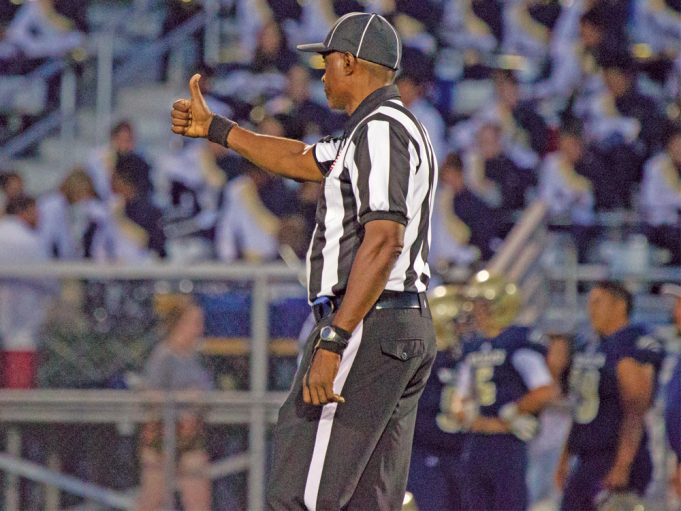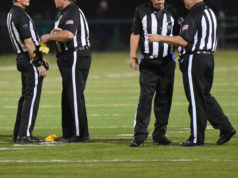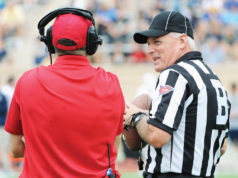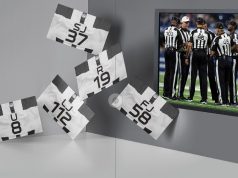R
eferees have a great deal on their plate. Before the opening kickoff they perform organizational duties, and conduct the pregame meeting and onfield tasks to get everyone ready to officiate the game.
But referees in a crew of five need help with several aspects of the game once it starts. Much of that assistance can come from wing officials who can verbalize or signal information to referees to help them make proper rulings and get administrative procedures correct.
Here are things wing officials can do before the snap.
Down number.
While holding up the down number on your hand, keep it up a little longer and make eye contact with the referee. That confirms you all are in sync for the next down. That is especially helpful after a game stoppage such as for penalty enforcement, timeout or after an injured player exits the field.
Double stakes signal.
That’s a reminder the line to gain is more than 10 yards from the snap and no one stops the clock when a play ends past the back stake.
Clock status.
A wing official may be tasked to tell the referee if the clock should next start on the ready or on the snap. Ensure that duty is assigned in the pregame meeting so the referee knows which official has that job. A suggestion: Crossed arms at waist level says clock starts on the snap and an index finger winding rotation says clock starts on the ready. Use whatever is required in your area.
Pass direction.
During a play, you can signal the direction of a pass (forward or backward). That helps the referee and other officials react accordingly. If forward, rule an incomplete pass if it hits the ground. If backward, everyone knows the ball is live should it contact the ground, no whistle should be sounded and the play should continue.
There is possible communication after a play ends.
First down.
Let the referee know if a first down was made. That can follow your stop-the-clock signal, or if your dead-ball spot is close to the line to gain, alert the referee to take a look to see if a measurement is required. In your pregame meeting, ask if you or the referee should stop the clock when a decision to measure appears necessary.
Player count.
Depending on local practice, a wing may share counting responsibilities with the referee. Decide in the pregame which signals will be used to indicate the count. An upraised thumb is commonly used to signify 11 players.
Penalty reporting and verification.
If you have a flag down, after calling timeout, give the referee all the data needed for proper penalty enforcement. Help with penalty administration by monitoring the signals and announcements. Do that even if you have penalty walkoff duty. Also ensure the referee correctly states special enforcement aspects such as loss of down, automatic first down or possible carry over to the next kickoff or period, etc.
Clock correction.
If you have positive knowledge the clock is wrong and needs adjustment, point that out to the referee. Get the onfield official who is timing the game involved to find out the correct time.
Intentional grounding.
Referees need help to know if an eligible receiver was in the area where a forward pass landed. Because referees monitor fouls against the passer after the ball is released, they might not see where the incomplete pass landed.
In NFHS, tell the referee whether or not an eligible receiver was in the area. If so, point to that receiver. Shaking the head can indicate no eligible in the area. In NCAA, two things create an exception to intentional grounding — the passer is or has been out of the tackle box, and the pass landed beyond the neutral zone or neutral zone extended. The referee determines the tackle box aspect while you rule if the pass crossed the neutral zone. In that case, receiver location does not matter.
Touching of a pass.
Your ruling of a pass touched behind or beyond the line is a factor in determining whether or not there may be a foul for pass interference or ineligibles downfield.
Timeouts.
During a team timeout stoppage, confirm with the referee and your crewmates how many timeouts each team has remaining.
What's Your Call? Leave a Comment:
Note: This article is archival in nature. Rules, interpretations, mechanics, philosophies and other information may or may not be correct for the current year.
This article is the copyright of ©Referee Enterprises, Inc., and may not be republished in whole or in part online, in print or in any capacity without expressed written permission from Referee. The article is made available for educational use by individuals.



















